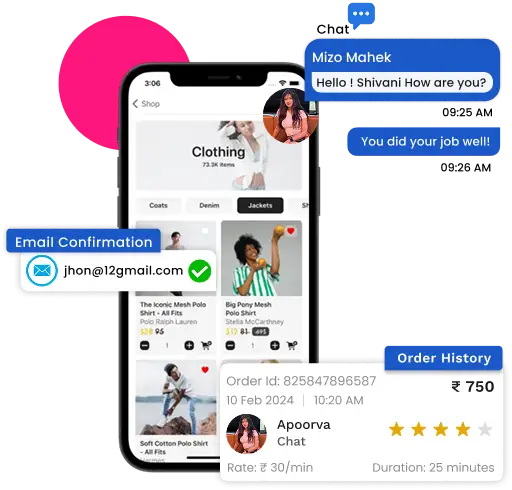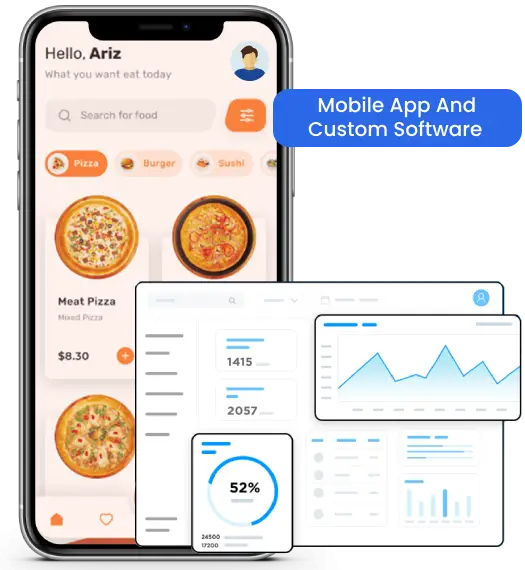Since 2016, the stock market has been on constant rise while the regular investors and traders are generating multibagger returns. Moreover, custom trading platform technology has also simplified the investment process for beginners and stockbrokers are also promoting it to expand their consumer base.
The projected average growth rate of the stock market is 6.4% annually for the next ten years. Although, there is an opportunity to grow your money at a high rate of return, people from every age group are leveraging this opportunity.
At the same time, it is an opportunity for budding stock companies to go digital by launching a dedicated application for trading. However, there are so many questions associated with custom trading platform development which we will discuss in this blog and share with you the exact procedure of building a trading application.
What is a Trading Software?
Trading software is a computer program that facilitates the trading and analysis of financial products like stocks, options, futures, or currencies. Additionally, it serves as a bridge between the trader and the financial market.
Types of Trading Software
Before proceeding, let us discuss the various kinds of trading software:
Brokerage Platforms: Offered by online brokers, these platforms provide basic trading functionalities and market data.
Professional Trading Platforms: Designed for experienced traders, offering advanced charting tools, algorithmic trading capabilities, and in-depth market data
Custom-Built Platforms: Developed for specific trading strategies or institutional traders
Core Features of a Trading Platform
A robust trading platform offers a range of tools and features to support informed decision-making and efficient execution of trades. Here are the core features:
Order Execution
- Order Types: Various order types (market, limit, stop, stop-loss, take-profit) to suit different trading strategies.
- Order Placement: Ability to place orders quickly and accurately.
- Order Modification: Modify or cancel existing orders.
- Order History: Track past orders for analysis and reference.
Market Data
- Real-time Quotes: Up-to-date prices for securities.
- Historical Data: Access to historical price data for analysis.
- Market News: Real-time news feeds and alerts.
- Economic Indicators: Key economic data for market analysis.
Charting and Technical Analysis
- Charting Tools: Various chart types (line, bar, candlestick) with customizable timeframes.
- Technical Indicators: Built-in technical indicators (moving averages, RSI, MACD, etc.) for analysis.
- Drawing Tools: Ability to draw trend lines, support/resistance levels, and other chart patterns.
Portfolio Management
- Account Summary: Overview of holdings, positions, and account value.
- Performance Tracking: Track portfolio performance over time.
- Portfolio Rebalancing: Tools to adjust portfolio allocations.
- Tax Reporting: Integration with tax software or generation of tax-related reports.
Research and Analysis
- Fundamental Data: Access to company financials, news, and analyst ratings.
- Screening Tools: Filter securities based on specific criteria.
- News and Alerts: Customizable news feeds and alerts.
Security and Compliance
- Data Encryption: Protection of sensitive user and account information.
- Regulatory Compliance: Adherence to financial industry regulations.
- Two-Factor Authentication: Enhanced security through multi-factor authentication.
Few Extra Features
- Mobile Trading: Access to platform functions through mobile devices.
- Social Trading: Ability to follow other traders and copy their trades
- Algorithmic Trading: Tools for creating and executing automated trading strategies.
- Paper Trading: Simulated trading environment for practice.
Benefits of a Trading Platform
Developing a custom trading platform offers numerous advantages for both the platform owner and its users:
For the Platform Owner
- Revenue Generation: Charging commissions, fees, or subscription fees for platform usage.
- Data Monetization: Leveraging user data for insights and potentially selling it to third-party firms.
- Brand Building: Establishing a strong brand identity in the financial industry.
- Competitive Advantage: Offering unique features or superior technology can attract users.
- Diversification: Potential to offer additional financial services, such as investment advisory or wealth management.
For the Platform Users
- Accessibility: Enables trading from anywhere with an internet connection.
- Speed and Efficiency: Faster order execution and real-time market data.
- Cost-Effective: Often lower transaction fees compared to traditional brokerages
- Customization: Users can tailor the platform to their specific needs and preferences.
- Advanced Tools: Access to sophisticated charting, analysis, and trading tools.
Overall Benefits
- Innovation: Driving innovation in the financial industry through new features and technologies.
- Market Efficiency: Also, contributing to more efficient and transparent markets.
- Financial Inclusion: Potentially expanding access to financial markets for a wider audience.
By creating a trading platform, you can tap into a vast market opportunity and build a successful business while providing valuable tools for traders and investors.
Developing My Own Trading Software
Developing your own custom trading software is a complex endeavor that requires deep knowledge of programming, finance, and market dynamics. Moreover, it’s often more practical and efficient to use established trading platforms or partner with a specialized development firm.
However, if you’re determined to build your own, you can refer to this detailed outline:
- Define Your Goals and Strategy
- Identify your trading style: Are you a day trader, swing trader, or long-term investor?
- Define your trading strategy: What algorithms or indicators will you use?
- Set your risk tolerance: How much risk are you willing to accept?
- Learn Programming and Financial Modeling
- Master a programming language: Often python, C++, or Java are common choices for trading software.
- Understand financial data structures: Learn how to handle market data, time series, and financial instruments.
- Grasp financial modeling concepts: Build models to simulate market behavior and test your trading strategies.
- Data Acquisition and Storage
- Choose a data provider: Select a reliable source for real-time market data (e.g., Bloomberg, Reuters, Yahoo Finance).
- Design a database: Create a database to store historical and real-time data for analysis.
- Data cleaning and preprocessing: Ensure data accuracy and consistency.
- Algorithm Development
- Design trading logic: Create algorithms based on your trading strategy.
- Back testing: Test your algorithms on historical data to assess performance.
- Optimization: Refine your algorithms to improve performance.
- Software Development
- Choose a development environment: Select tools for coding, testing, and debugging.
- Build the user interface: Design a user-friendly interface for monitoring trades and managing your portfolio.
- Integrate with brokerage: Establish connections with your chosen broker for order execution.
- Testing and Refinement
- Rigorous testing: Test your software under various market conditions.
- Monitor performance: Track the software’s performance and make necessary adjustments.
- Iterative improvement: Continuously refine your algorithms and software based on results.
- Risk Management
- Implement stop-loss and take-profit orders: Protect your capital from significant losses.
- Position sizing: Determine appropriate position sizes based on risk tolerance.
- Diversification: Consider spreading investments across different assets.
- Compliance and Security
- Adhere to regulations: Ensure your software complies with financial regulations.
- Protect sensitive data: Implement robust security measures to safeguard user information.
Important Considerations
- Complexity: Developing trading software is highly complex and requires significant expertise.
- Market Dynamics: The financial markets are constantly changing, so your software needs to adapt.
- Costs: Factor in development, hardware, data, and operational costs.
- Alternatives: Consider using existing trading platforms, else partner with a reputed development firm.
Summary
Developing your own trading software can be challenging if you do not have a sound understanding of the trading world and development ecosystem. As you need to combine the best of both worlds, therefore building the trading software on your own cannot be easy, you need to rely on a genuine custom software development company in India. Only the prominent development firms have seasoned developers who have the industry level knowledge necessary for building a custom trading platform.
By partnering with Dreamer Technoland, you can easily get access to all the resources and packages necessary for the deployment of your application. Although, our technical team carries exceptional knowledge and experience in building reliable financial products like trading applications. Get in touch to learn more about how we can help you in meeting your custom trading platform development needs.







